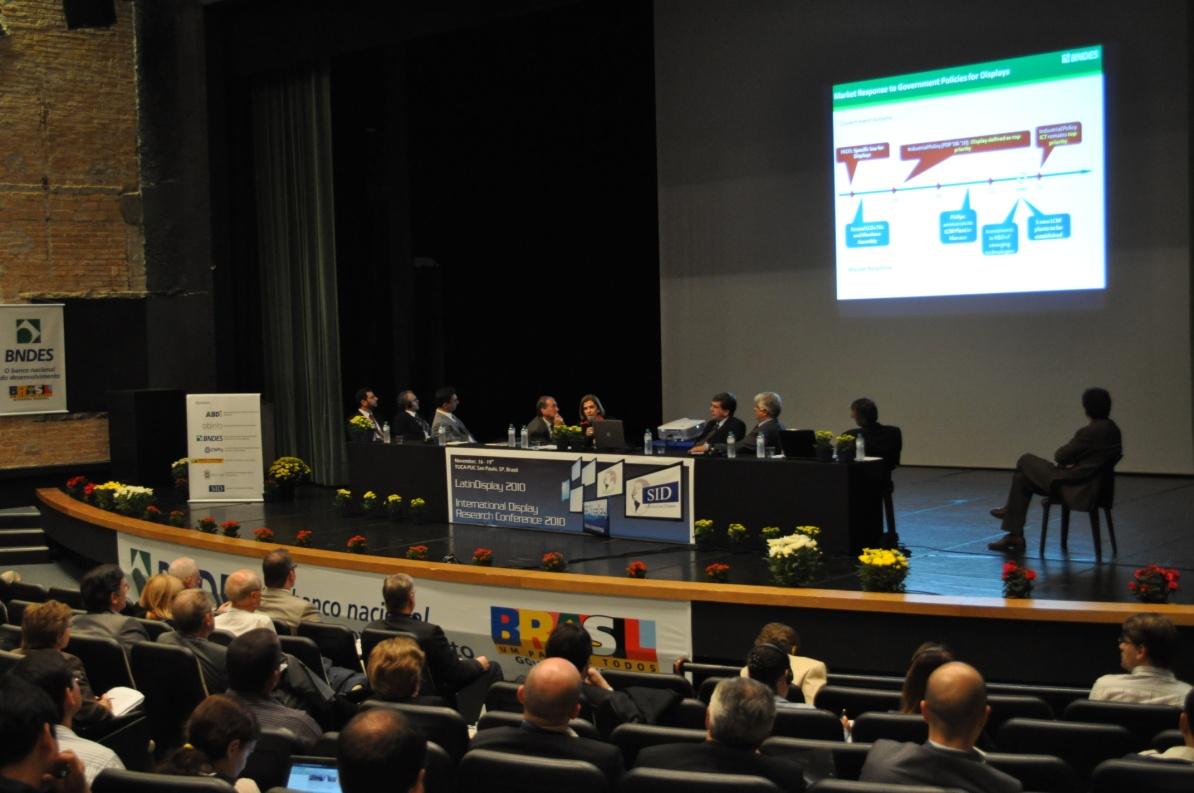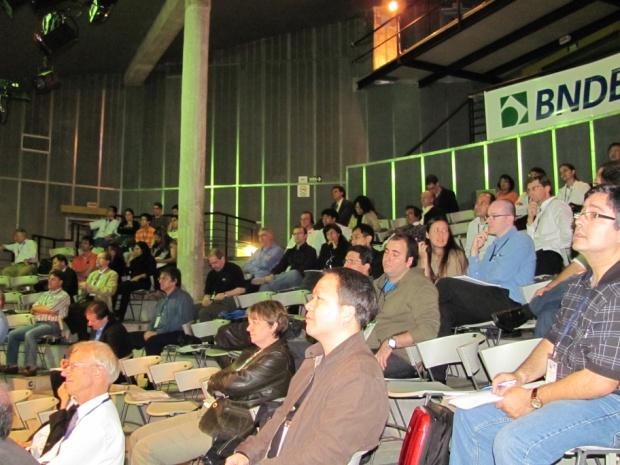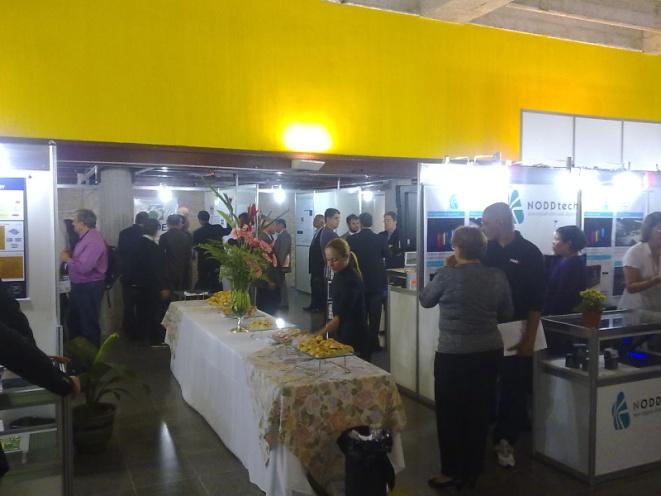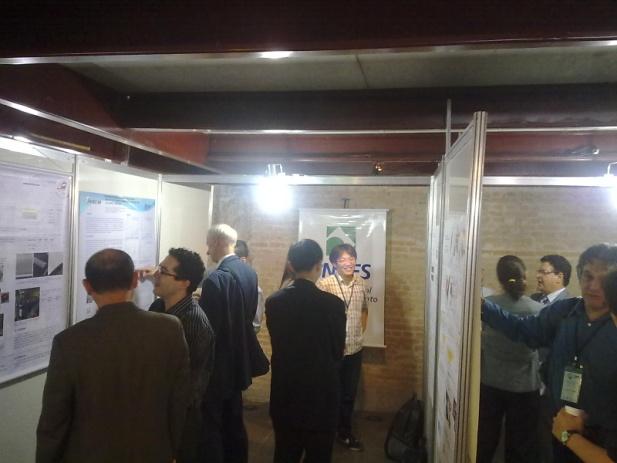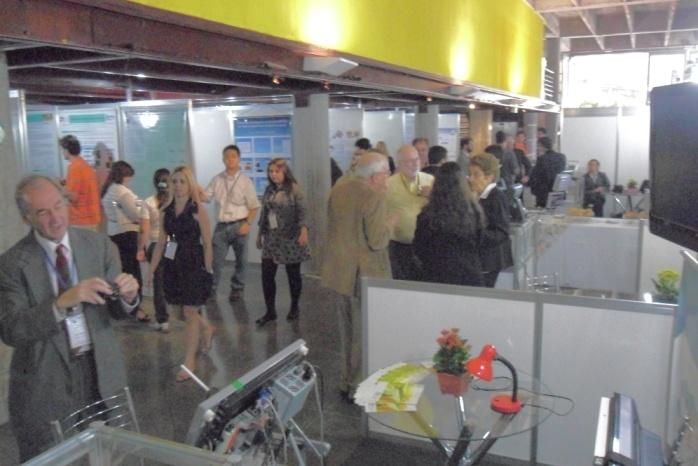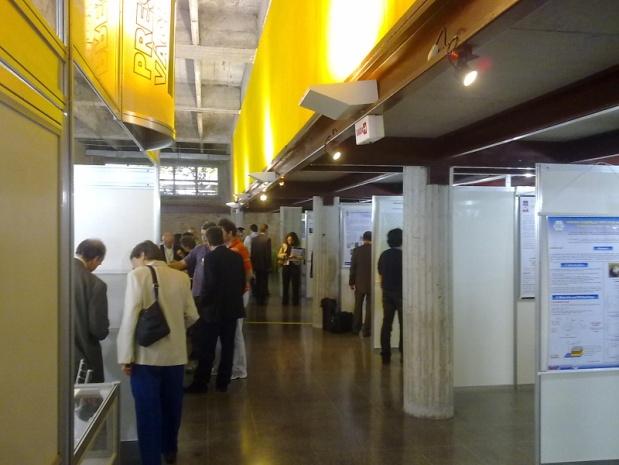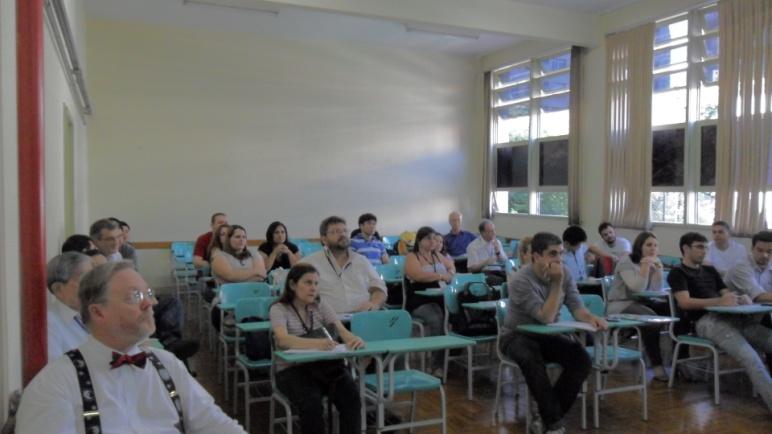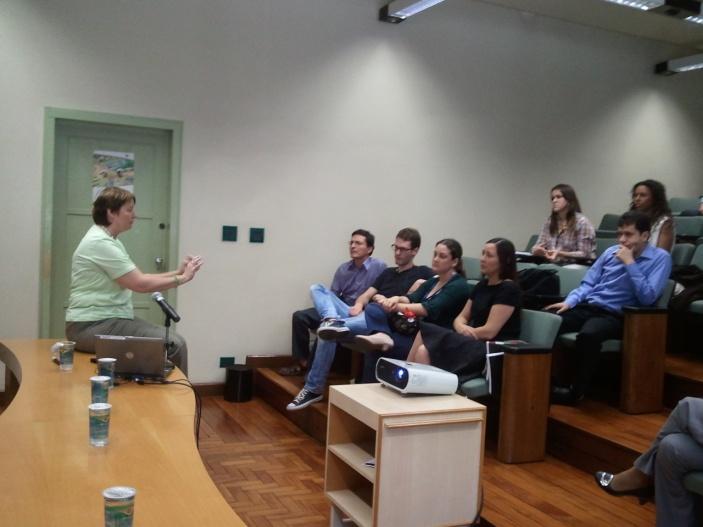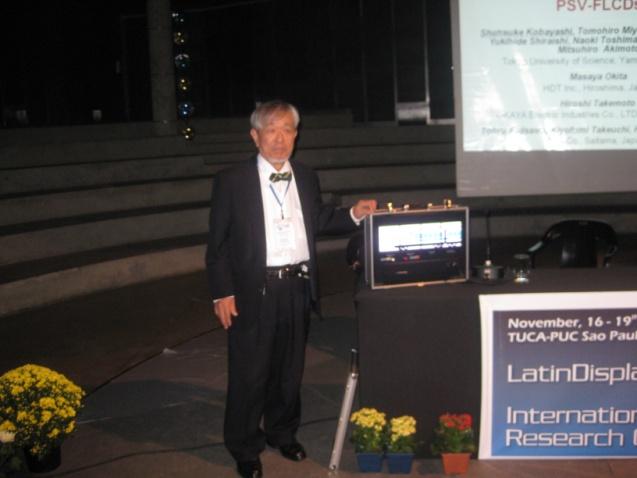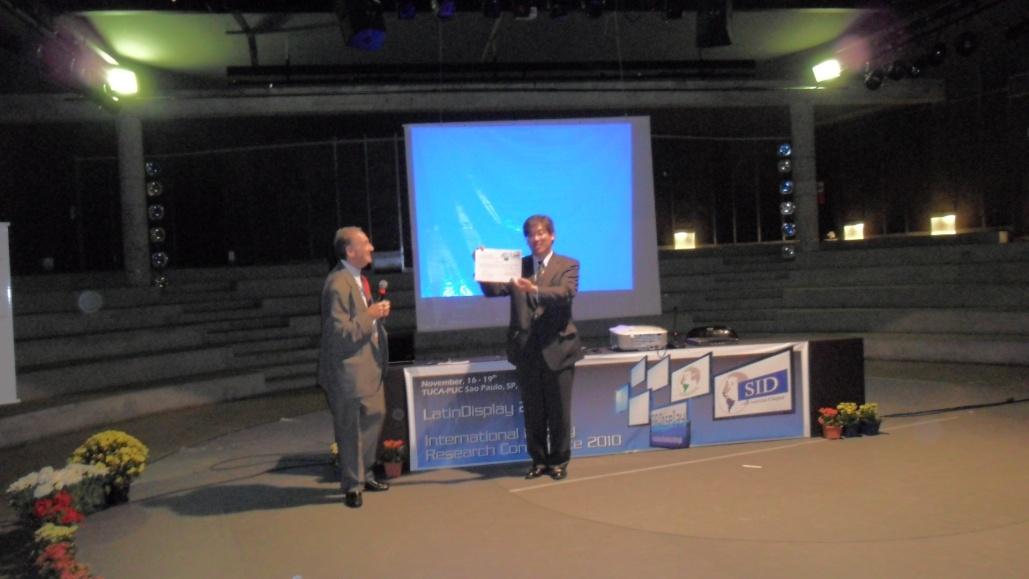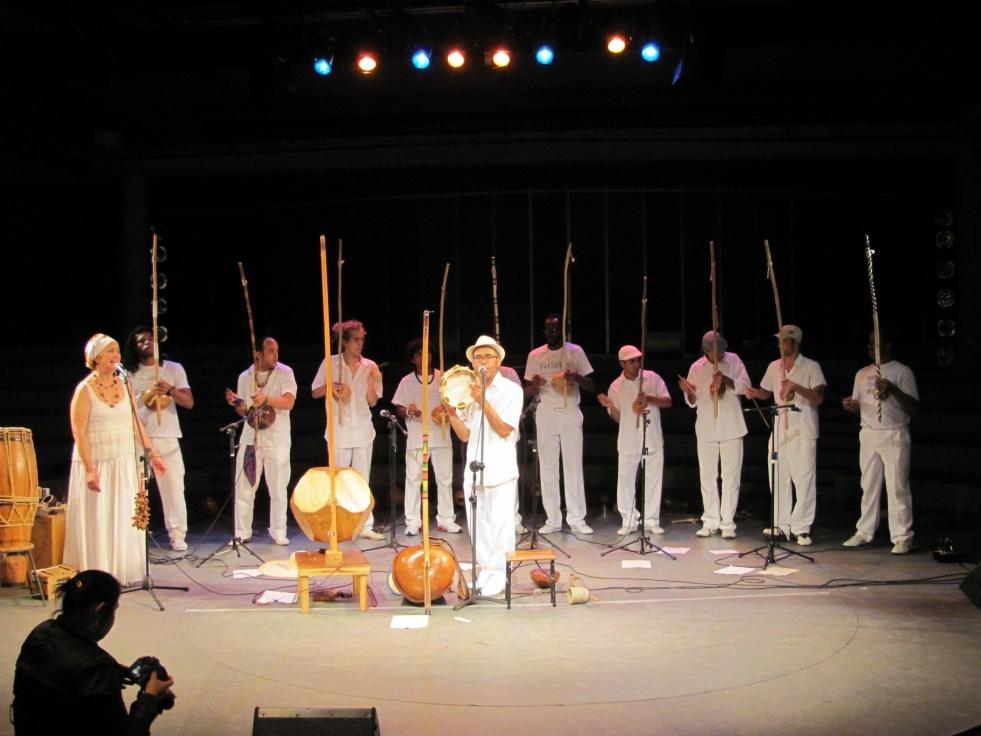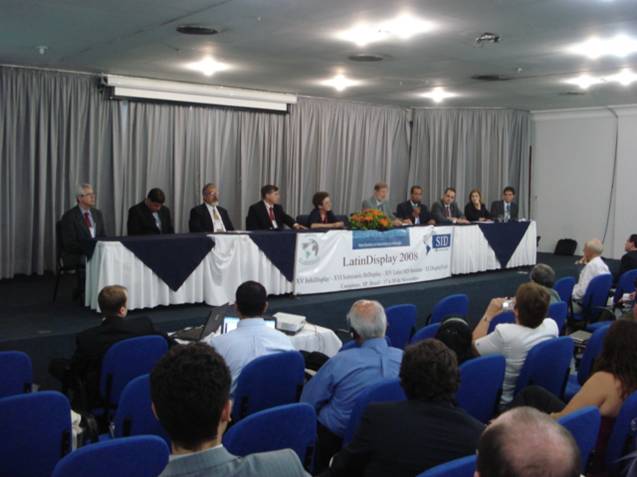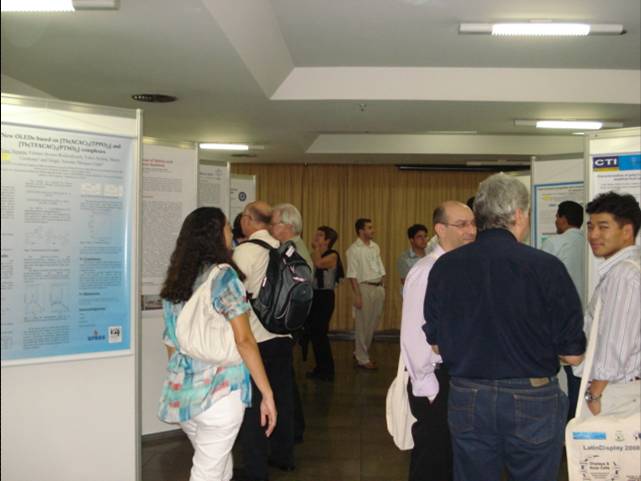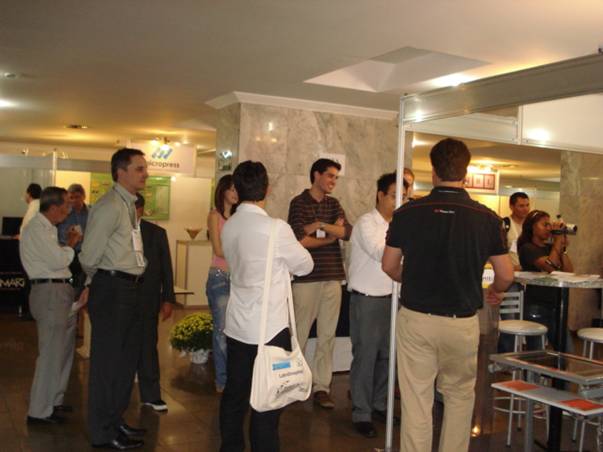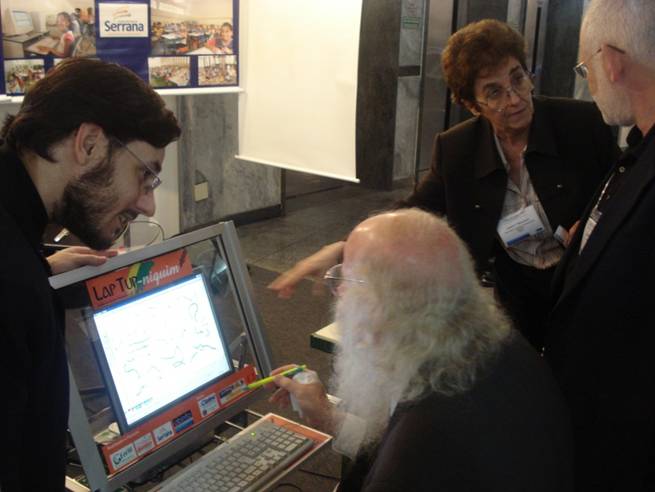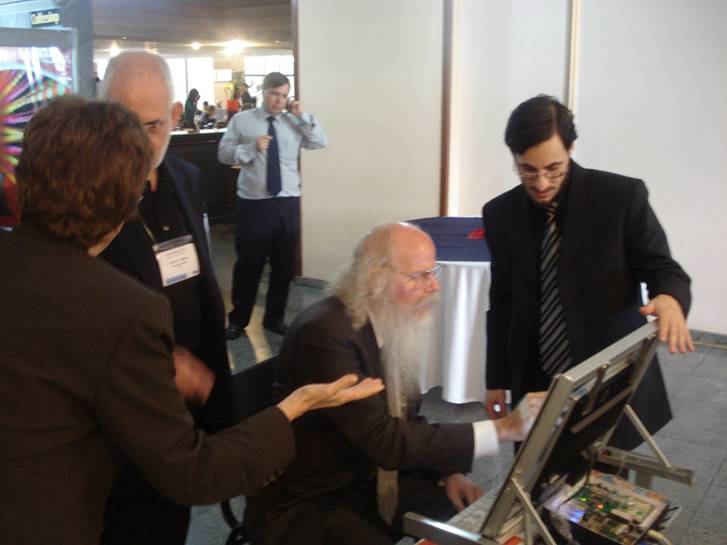Past LatinDisplayLatinDisplay 2010/IDRC 2010 The world came to Brazil to discuss displays LatinDisplay 2010, the Latin American annual event on displays and related technologies was held at the Pontifical University of São Paulo (PUC-SP), in São Paulo, Brazil, in November 16 to 19th. This year LatinDisplay was combined with the International Display Research Conference (IDRC 2010) – the first time that IDRC occurred in the Southern Hemisphere.
In the Symposium scientists from all over the world presented the latest advances in display technologies, display manufacturing, visual perception, TV and 3D-TV. Other technologies discussed because of their direct relationship to displays were touch screens, solar cells, lighting (fluorescent lamps, LEDs, and OLEDs), organic electronics, batteries, including their materials, processes and equipment. Twenty-three invited lectures were presented (3 from Brazil, 9 from the US, 6 from Europe, 2 from Japan, 1 from China, 1 from Taiwan, 1 from India), and 42 contributed papers were presented orally (7 from the Far East, 1 from Chile and 1 from Argentina), and as posters (6 from the Far East, 1 from Cuba and 26 from Brazil).
The Exhibition was a showcase for companies and R&D institutions to unveil cutting edge developments of display and related technologies by demonstrating prototypes and products. More displays and related devices have been exhibited in each succeeding year at LatinDisplay, with the exhibits attracting more and more attention from the media and the public. The show contributed substantially to the success of the conference by providing networking opportunities, as well as the ability to see and discuss the technical innovations on display. The show was open to the general public, and visitors were not required to registered in order to attend the show.
The Display Escola (Display School), held November 19 on another campus of PUC, attracted about 35 people to learn more about OLEDs (course taught by Manju Rajeswaran from Kodak, USA), measuring displays (by Adi Abileah, Planar Systems, USA) and visual perception (Ingrid Heynderickx, Philips Research Labs and the Univ. of Delft, The Netherlands).
The Business Meetings provided a forum to discuss trends and business opportunities in displays and related technologies in Brazil and all of Latin America. It was clear that interest in doing business in Brazil is accelerating, and Brazilians and non-Brazilians could be seen in earnest conversations.
Figure . Round Table on “The Impact of Displays and Internet in the Media and Editorial World” coordinated by Ken Werner, from Nutmeg Consultants
Figure . Shunzuke Kobaayahi presenting a prototype of a ferroelectric LCD. Lighting was also extensively discussed, with lectures on OLED lamps (Novaled and Philips), LEDs (Walsin Lihwa, Taiwan), and new lamp phosphors (University of Brunel, England).
Figure .The award for “Best Contributed Paper of LatinDisplay 2010/IDRC 2010” was given to Yasuhiro Yoshida, from Sharp.
Figure . Berimbau Orchestra at LatinDisplay 2010/IDRC 2010. The driving forces behind LatinDisplay 2010/IDRC 2010 were Victor P. Mammana (CTI/MCT, Brazil), General Chairman; Adi Abileah (Planar Systems), Program Chairman; and Daniel den Engelsen (Abinfo, Brazil), Program Co-Chairman. Without their exceptional energy and stimulating leadership, LatinDisplay/IDRC/2010 would not have been possible. LatinDisplay 2009 by Daniel den Engelsen LatinDisplay 2009, the premier Society for Information Display conference in the Southern Hemisphere, took place in SĂŁo Paulo, Brazil, on November 16–19, 2009. The venue for the third annual event was the Perdizes campus of the PontifĂcia Universidade CatĂłlica de SĂŁo Paulo (PUC-SP), where the organizers held a symposium with oral presentations, a poster session, and an exhibition run in parallel to the conference. The Display Escola (Display School), a special program for those who wanted to learn more about displays, took place on November 19 at another campus of PUC, having about 35 people in attendance. LatinDisplay 2009 had approximately 280 participants over the 3 days – a record for this conference. LatinDisplay has definitely come of age as a member of the family of SID conferences. There are several reasons behind this growing popularity. First, LatinDisplay has a unique conference formula; it is basically a one-track conference with no parallel sessions, featuring oral presentations by famous display experts from all over the world. Second, the speakers are carefully selected and instructed to present topics in a way that will be of interest to a broad audience of attendees, including students, company managers, university professors, bankers, and government authorities, as well as experts from display-related institutes and industries. The highlighted areas at LatinDisplay 2009 were OLEDs, e-Readers, and displays for medical applications. Apart from a gripping lecture by Dr. Manju Rajeswaran, Senior Scientist at Kodak, on the analysis of OLED materials, the focus on OLEDs was on lighting applications. Dr. Gopalan Rajeswaran, Vice President of Moser Baer, reviewed recent developments in organic solid-state lighting and Dr. Tom Munters, Product Manager at Philips Lighting for OLED-based lighting, described Philips's activities in this field. Ken Werner, Senior Analyst at Insight Media, described the developments in the field of e-paper, notably e-Readers. The avalanche of products now on the market demonstrates that e-paper technology is maturing. The third highlight was a presentation from Dr. Adi Abileah, Chief Scientist at Planar Systems, on displays for medical applications. His presentation was also the perfect introduction for a subsequent panel discussion on displays and information systems for healthcare and hospitals. That discussion featured Ken Werner, John Jacobs of DisplaySearch, Gabriel Marcu of Apple Computers, Adi Abileah, and Cecil Cho of USP in Brazil. In addition to these highlights, there were many other invited lectures with content that was of interest to specialists as well as a broad audience. The lively Q&A sessions after the presentations showed that audience members were highly engaged. Perhaps LatinDisplay's successful, one-track formula is ready to be copied by other chapters of the SID. It should be noted that a second attractor for LatinDisplay is the current policy of the Brazilian government to attract the display industry to Brazil to counteract a trade deficit of about US$2 billion due to huge panel imports. The policy and financial instruments that are available in Brazil to attract display-related industry were presented by Dr. Margarida Baptista of the Banco Nacional de Desenvolvimento EconĂ´mico e Social" (BNDES) and by Dr. Pedro Alem of the Agencia Brasileira de Desenvolvimento Industrial (ABDI). The poster session during LatinDisplay 2009 (40 posters in total) was a good opportunity for young scientists to show their newest results in supporting technologies for displays, solar cells, and lighting. Awards were given for both the best student and non-student posters. The exhibition parallel to LatinDisplay 2009 was modest, with only 16 booths. Nevertheless, the central location of the venue supported networking activities between the participants, and for this reason the exhibition was an attractive place to show services and products. Finally, the hospitality of the Brazilians, especially the hostess of LatinDisplay 2009, Professor Alaide Pellegrini Mammana, amid the warm Brazilian culture, once again provided the finishing touch to a successful LatinDisplay. Please visit the Web site of LatinDisplay 2009 to learn about forthcoming LatinDisplay conferences at http://www.brdisplay.com.br/latindisplay. LatinDisplay 2010 has been scheduled for November 16-19. Alaide and Victor Pelligrini Mammana look forward to welcoming you to Brazil for the next and most exciting LatinDisplay yet. LatinDisplay 2008 LatinDisplay 2008 was held in Campinas (Brazil) from November 17-20, 2008 at the Hotel Nacional Inn in Campinas, where we had the Symposium with oral presentations, a Poster Session and an Exhibition, on November 17-19, and the Display Escola (Display School) on November 20 for people who wanted to learn more about displays. The number of participants was 228, the majority from the State of SĂŁo Paulo, viz. 153, 40 came from other States of Brazil and 35 participants came from abroad, the largest group being from the USA (12). Figure 1. shows a picture of the Opening Session of LatinDisplay 2008. Invited speakers (23) from Brazil, USA, Netherlands, India, Italy, Finland, Germany, Japan and Singapore presented the following lectures:
The quality of these presentations was excellent and the ample discussions after the lectures showed the interest and the participation of the audience. This was the best compliment to the lecturers, indicating that they were able to present their material in a comprehensible way to many non-experts in the audience. The leading display technologies and applications were presented and the lectures gave an excellent view on the state-of-the-art and what can be expected on short notice. The lectures on Monday November 17, numbered1-5 in the list above, focused on markets and market opportunities for display industry in Brazil. The day culminated in a round table discussion, chaired by Ken Werner (InsightMedia). The lectures of Jyrki Kimmel, Gopalan Rajeswaran, Margarida Baptista, Anis Fadul and John Jacobs were an excellent warming-up for this discussion. As in previous events, the theme was again how Brazil could attract manufacturing industry in the field of displays and solar cells. Apart from Dr Margarida Baptista two other members of the Brazilian “Banco Nacional de Desenvolvimento Econômico e Social” (BNDES), as well as a representative of the “Agência Brasileira para o Desenvolvimento Industrial” (ABDI) participated in the panel discussions. BNDES is a federal public bank that is associated to the Ministry of Development, Industry and Foreign Trade of Brazil; one of the objectives of the bank is long-term financing of innovative start-up companies resulting in the creation of high quality jobs in Brazil. During the lively discussions some interesting ideas were presented that will receive follow-up from a special working group that was established by the Brazilian Government within the framework of a recent Federal Industrial Policy to stimulate/start industrial activities on displays in Brazil. From an industrial point of view the role of Latin America is insignificant in the Display Scene: the center of gravity of display production is in the Far East, whereas the new innovations on 3D-displays and flexible displays are largely coming from Europe and the USA. However, in applications Latin America is playing a role. The highlight is the digital student desk equipped with PC and tablet: this is a Brazilian innovation, which is gaining momentum now in Brazil and also abroad. This student desk received a great deal of attention at LatinDisplay 2008 during the lecture of Dr Victor Mammana and at the exhibition parallel to the symposium. Whilst it is tempting to comment on other presentations as well, because the interesting points they raised, it is not practical to do this. Nevertheless it is important to mention that this formula for conferences and round table represents one of the best means of informing on new trends and technologies for displays on a seminar level, with the Brazilian ambiance providing the finishing touch ! In the poster session 50 posters were presented and the best student poster was awarded. Figure 2 shows a picture of the Poster Session. At the Exhibition 15 exhibitors showed their products and services. Figure 3 shows a picture of the Exhibition. On November 20, in the wake of the conference, there were 25 participants in the DisplayEscola (School). This activity was organized by the Associação Brasileira de Informática (ABINFO), whose objectives are to promote and develop human friendly and environmentally friendly technology in Brazil and worldwide. The digital student desks were also used during this display school as can be seen in Figure 4. Daniel den Engelsen
Figure 1. Opening ceremony of LatinDisplay 2008.
Figure 2. View of the poster session at LatinDisplay 2008
Figure 3. Exhibition parallel to LatinDisplay 2008
Figure 4. Students of the Display School of LatinDisplay 2008 working at the Digital Student Desk equipped with the Brazilian digital tablet. LatinDisplay 2007 An event of the Latin American SID Chapter, of the Brazilian Network on Displays (BrDisplay Network) and of the Ibero American Network on Displays, this conference was a merge between info-display meetings and display seminars organized over the past 14 years in Ibero America. The conference was organized by the Associação Brasileira de Informática (ABINFO), a cooperative association for R&D on displays and other fields of expertise, together with Centro de Tecnologia da Informação (CTI). With 189 participants from several countries, 170 from Latin America, 9 from the USA, 6 from Europe, 2 from Taiwan, 1 from China and 1 from India, the event comprehended the presentation of invited lectures given by experts (19) from all the world, a session of contributed papers presented as posters (50) and an Exhibition with 16 exhibitors. Being the center of gravity for the display industry in the Far East, notably Taiwan, Japan, Korea and China, with a turnover of more than 100 billion US-dollars, why organize an international conference on display technology in Brazil? One of the reasons is the growing deficit in the trade balance of Brazil in the field of electronic devices. Brazil had a display manufacturing activity for a long time, notably on cathode ray tubes. This manufacturing activity has stopped recently because of the declining sales for cathode ray tubes. The assault of flat panel displays based on liquid crystal and plasma technology is irreversible and it has already wiped out the cathode ray tube industry in the Far East, Europe and North America. The price of TV-sets with liquid crystal displays (LCDs) and plasma display panels (PDPs) has been dropping in recent years by approximately 25% per year making them affordable for many people in Latin America. This trend in displays will substantially contribute to the unfavorable trade balance between Latin America and the Far East on high tech devices. One of the objectives of Latin Display 2007 was to address this trend and what initiatives are needed in Latin America, notably Brazil, in dealing with this economic development. In addition to discussing economic aspects, the conference offered ideal opportunities for the participants to extend their network, exchange information, consider cooperation and so on. These latter aspects were reinforced by a small exhibition parallel to the conference. Some institutes such as the Campinas-based Centro de Tecnologia da Informação (CTI) and the ABINFO, Brazilian and foreign companies provided information on their display-related activities and showed their products and prototypes. Various lectures given during the conference dealt with the dominance of the Liquid Crystal Display (LCD) technology emphasizing that LCDs will be the most important display technology in the coming decade, because of adequate picture quality and low cost. Much attention was also paid to an emerging technology, the Organic Light Emitting Diodes (OLEDs), which is already applied in cellular phones, but is now also applied in an 11 inch TV, to be introduced in the market by Sony next month. The picture quality of OLEDs is surprisingly good and many experts expect that OLEDs will be cheaper than LCDs in the future. However, that will depend largely on the economy of scale, since it requires that the complete production chain for OLEDs must be in place. Display experts from all over the world gave lectures, which provided a unique survey on the broad spectrum of display technologies. The keynote address was presented by Dr. Margarida Batista of the Banco Nacional de Desenvolvimento Econômico e Social (BNDES) of Brazil, who gave an intriguing lecture on investing in Brazil: “Brazil: a promising place to invest”. LatinDisplay 2007 offered ample time for brainstorming and discussing initiatives for creating industrial display activities in Latin America, mainly Brazil. In the afternoon of November 12 there was a lively round table discussion between economists and technical experts. Two excellent lectures served as warming up for this round table discussion, the first by Dr. Samuel Chung, until recently working as CTO in KODAK, on the critical success factors of the display industry, and the second by Dr. Baptista (BNDES), who explained the financial tools and the support of BNDES for starting new activities and companies. Due to an emergency Dr. Chung could not attend the conference, but he was “on line” present via skype, including webcams, and the audience could interact with him directly. This was an interesting demonstration of modern communication technology. According to Dr. Chung, one of the main characteristics of the display industry is long term vision, which requires a long term investment plan: this is opposite to the current impatient behavior of investors. Other critical success factors of the display industry are critical mass and cooperation along the production chain. Since Brazil and other countries outside Far East region have neither a large “display mass”, nor a sufficiently well developed production chain for LCDs, PDPs or OLEDs, the inevitable conclusion is that Brazil and these other countries need international cooperation to start display manufacturing activities. On the other hand, there are plenty opportunities for creative entrepreneurs in Latin America for special display applications, which do not depend on massive investments in LCD-fabs. A nice example of such an opportunity was given by Dr. Victor Mammana, head of the display group of CenPRA, in his lecture presenting a new tablet. A versatile input device for computers, this particular tablet, based on a thin layer of tin oxide on a glass plate, is a good example of a Brazilian innovation, ready to be introduced into the market. We are used to the traditional key board and mouse as input devices; however, a tablet presents a more natural way for inputting drawings, graphs and other data. Besides individual use, a tablet offers new opportunities in schools, for teaching basic disciplines like arithmetic, writing and language but also to assist children developing their creativity. At the exhibition a new student desk to support working with large size tablets of about 50x40cm2 were shown (Figure 1. and Figure 2.). This desk will be used by 4000 students in Serrana, a city of 40000 in the State of São Paulo; the prototypes were built in CIATEC (Companhia de Alta Tecnologia de Campinas) of Municipal Government of Campinas, where ABINFO is located.
Figure 1. A student desk with an innovative touch screen based on a thin film of tin oxide was shown in the booth of City of Serrana at LatinDisplay 2007 Exhibition.
Figure 2. Larry Weber, President of SID, is testing the student desk in the booth of City of Serrana at LatinDisplay 2007 Exhibition. LatinDisplay 2007 received a great deal of attention from the Brazilian media due to the high tech content of displays. Eight Brazilian TV-channels showed pictures and interviews with organizers and participants of the conference in prime time. Also various Brazilian newspapers reported on this conference. Because of the broad scope of LatinDisplay 2007 various new business contacts were established and new opportunities for R&D were discussed and may get a follow up. This is a feather in the cap of the organizers of an interesting and stimulating conference. Daniel den Engelsen | ||||||||||||
.jpg) |
